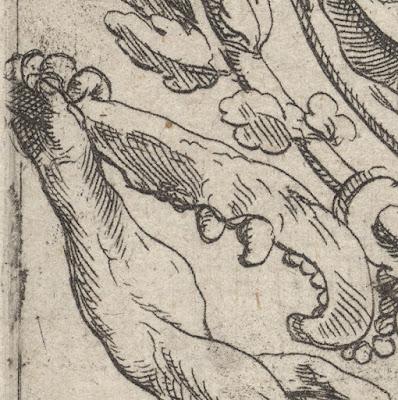Odoardo
Fialetti (1573–1626/27)
“A Satyr with a Jawbone Striking a Lion who attacks a Man” (TIB
title), c1625, from the series of ten plates (including the titlepiece), “Vertical
Grotesques” (aka “Disegni varii di Polifilo Zancarli”), after Polifilo Giancarli (fl.c.1620–57) (“Disegni varii di Polifilo
Zancarli”), possibly published by Tasio
Giancarli (fl.1625) in Venice.
Etching with plate tone on laid paper with small margins backed
with a support sheet.
Size: (sheet) 25.4 x 16.4 cm; (plate) 23.9 x 15 cm; (image
borderline) 22.4 x 14.7 cm
Inscribed on plate below the image borderline: (left) ”Poliphilvs
Giancarli In.”; (right) “OF [monogram] inci”
State i (of i)
TIB 38.49 (Sebastian Buffa [ed.) 1983, “The Illustrated Bartsch:
Italian Artist of the Sixteenth Century”, vol. 38, p. 239); Bartsch XVII.280.49;
Berlin 1939 559 (P Jessen 1939, “Katalog der Ornamentstichsammlung der
Staatlichen Kunstbibliothek Berlin”, Berlin).
The Rijksmuseum offers the following description of this print:
(transl.) “The lower body of the man who gets bitten ends in a
leaf with flowers. Leaf from series of 10 sheets with vertical panels full of
foliage, figures and animals.”
See also the description of this print at the British Museum:
Condition: crisp impression showing very little wear to the
printing plate in very good condition (i.e. there are no tears, holes, folds, abrasions
but there are a few minor marks commensurate to the age of the print). The sheet
has small margins and is laid onto a support sheet of archival (millennium
quality) washi paper.
I am selling this exceptionally rare etching for AU$350 in total
(currently US$249.95/EUR217.90/GBP191.78 at the time of posting this listing)
including postage and handling to anywhere in the world (but not, of course,
any import duties/taxes imposed by some countries).
If you are interested in purchasing this early masterpiece of ornamental
design, please contact me (oz_jim@printsandprinciples.com) and I will send you
a PayPal invoice to make the payment easy.
This print has been sold
Although I often stumble into the dangerous territory of making broad
generalisations, I feel compelled once again to propose a sweeping statement
that helps to explain the slightly silvery quality of this rather beautiful
etching … (hold your breath for a second as I make a statement that I will
probably regret in the future): Italian printmakers and draughtsmen in the 16th
and 17th centuries tended to use organic based blacks which lends
their artworks a greyish tonality compared to the German artists of the same
period who tended to use mineral based blacks which gives their artworks strong
tonal contrasts.
Now that I’ve made my very arguable proposal, this print is not an
impression taken from a worn plate, but rather it is an impression made with a
greyish coloured ink. If I may go a little further with very debatable generalisations—and this time I fully expect to be hauled over hot coals—Italian printmakers tend
to be less fastidious in the way that they ink and pull their prints compared
to the German printmakers of this time period. This leaning not to care too
much helps to explain the curiously interesting thumb print of the printmaker that may be seen on the left arm of the chap being attacked by the lion. Lack of concern,
also helps to explain the crumbled edge on the left side of this impression
that signals (at least to me) that the press pressure was not adjusted perfectly.
(My apologies if my sweeping statements are too sweeping.)









No comments:
Post a Comment
Please let me know your thoughts, advice about inaccuracies (including typos) and additional information that you would like to add to any post.